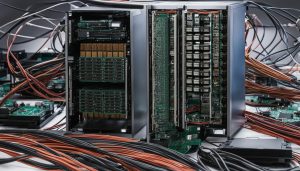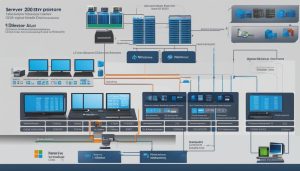Welcome to my comprehensive guide on Windows 2000! In this article, I will walk you through everything you need to know about this operating system released by Microsoft in the year 2000. Whether you’re curious about its features, system requirements, or its usability in both business and personal environments, I’ve got you covered.
Windows 2000 was a significant milestone in the Windows NT operating system, introducing numerous improvements over its predecessors. From enhanced networking capabilities to improved stability and support for new hardware, it brought a range of features that made it a popular choice for businesses and individuals alike.
Key Takeaways:
- Windows 2000 is an operating system released by Microsoft in 2000.
- It introduced active directory, improved plug-and-play support, better stability, and support for more hardware.
- The system requirements for Windows 2000 include a 133MHz CPU, 64MB of RAM, and around 2GB of free hard drive space.
- Windows 2000 was designed for business environments, offering features such as Active Directory and file and printer sharing.
- While it can be used for personal purposes, it may not be practical due to lack of support and compatibility with modern software and hardware.
Windows 2000 System Requirements and Compatibility
When considering whether to install Windows 2000 on your computer, it’s essential to understand the system requirements and compatibility of this operating system. Released in the year 2000, Windows 2000 has specific hardware and software prerequisites that need to be met for optimal performance.
The minimum system requirements for Windows 2000 include a 133MHz or faster CPU, at least 64MB of RAM (although 128MB is recommended), and approximately 2GB of free hard drive space. These requirements were suitable for computers at the time of its release but may not be sufficient for modern-day machines. It’s important to note that Windows 2000 primarily supports 32-bit architecture; however, there is a limited 64-bit version available.
While Windows 2000 can still be installed on some older hardware, it is not recommended for daily use on modern computers due to its outdated nature and lack of security features. The operating system is no longer supported by Microsoft, which means it doesn’t receive regular updates or security patches. This leaves it vulnerable to security threats and makes it less practical for everyday use.
Table: Windows 2000 System Requirements
– CPU: 133MHz or faster
– RAM: 64MB (128MB recommended)
– Hard Drive Space: Approximately 2GB
– Architecture: Primarily 32-bit, limited 64-bit version available
– Support: No longer supported by Microsoft, no regular updates or security patches
In summary, while Windows 2000 offers certain capabilities and improvements over its predecessors, it is not the most suitable operating system for modern-day computers. Its system requirements and lack of support make it less practical for everyday use. It may still be useful in certain scenarios, such as running legacy software or setting up a small business network, but for better security and compatibility, it is recommended to consider newer operating systems.
Using Windows 2000 in Business Environments
Windows 2000 was specifically designed for business environments, offering a range of features and advantages. One of the key highlights of Windows 2000 is its support for Active Directory, a centralized system for managing networks. With Active Directory, businesses can efficiently manage user accounts, security policies, and network resources.
In addition to Active Directory, Windows 2000 also provides robust file and printer sharing capabilities. This allows businesses to easily share files and printers across the network, enhancing collaboration and productivity. The improved stability and performance of Windows 2000 compared to its predecessors further contribute to its suitability for business environments.
Advantages of Using Windows 2000 in Business Environments:
- Active Directory support for efficient network management
- Enhanced file and printer sharing capabilities
- Improved stability and performance
However, it is important to note that Windows 2000 is no longer supported by Microsoft. This means that there are no more security updates or patches available, making the operating system vulnerable to security threats. It is therefore crucial for businesses using Windows 2000 to implement additional security measures to protect their systems and data.
Disadvantages of Using Windows 2000 in Business Environments:
- No longer supported by Microsoft
- Vulnerability to security threats
- Lack of access to latest features and updates
Despite its disadvantages, Windows 2000 can still be a viable option for certain business scenarios, especially for those with legacy systems or specific software requirements. However, it is recommended to consider upgrading to a newer operating system that offers better security, support, and compatibility with modern software and hardware.
Windows 2000 in Business Environments |
|
|---|---|
| Advantages | Disadvantages |
| Active Directory support | No longer supported by Microsoft |
| Enhanced file and printer sharing capabilities | Vulnerability to security threats |
| Improved stability and performance | Lack of access to latest features and updates |
Windows 2000 for Personal Use and Compatibility
While Windows 2000 can be used for personal purposes, it may not be practical due to its lack of support and compatibility with modern software and hardware. As an outdated operating system, Windows 2000 does not receive regular updates or security patches from Microsoft, which makes it more vulnerable to security risks.
One of the main disadvantages of using Windows 2000 for personal use is the lack of compatibility with modern software. Many applications and programs have been developed specifically for newer operating systems, and they may not work properly or at all on Windows 2000. This includes popular software such as web browsers, media players, and productivity tools.
In terms of hardware compatibility, Windows 2000 may also pose challenges. As technology has advanced since its release, newer hardware components and peripherals may not have drivers available for Windows 2000. This means that certain devices may not work or may not operate at their full potential when connected to a computer running Windows 2000.
Furthermore, without official support from Microsoft, troubleshooting issues or resolving compatibility problems can be more difficult. While there may be online communities or forums where users can seek assistance, it is important to note that the information provided may not always be accurate or reliable.
In conclusion, while Windows 2000 can still be used for personal purposes, it is not recommended due to its lack of support, compatibility issues, and vulnerability to security risks. It is advisable to consider upgrading to a newer operating system that offers regular updates, better compatibility, and enhanced security features.
Windows 2000 Networking and Internet Access
Windows 2000 offers robust networking capabilities, making it suitable for both small and large businesses. With features like built-in support for file and printer sharing, Windows 2000 allows users to easily connect and share resources within a network. Additionally, it supports small business networks through features like Active Directory, which provides centralized management of network users, groups, and permissions.
When it comes to internet access, Windows 2000 includes Internet Explorer as the default web browser. While Internet Explorer served as the primary browser for many years, it is no longer supported by Microsoft and is not recommended for browsing the modern internet due to security vulnerabilities. However, users can install alternative browsers, such as Google Chrome or Mozilla Firefox, to access the internet on Windows 2000.
It is important to note that Windows 2000 lacks the latest security features found in modern operating systems. This makes it less secure when accessing the internet, as newer threats and vulnerabilities may not be adequately addressed. It is advisable to consider upgrading to a more recent operating system, such as Windows 10, for improved security and compatibility with modern software and hardware.
Table: Comparison of Windows 2000 Network Features
| Feature | Description |
|---|---|
| File and Printer Sharing | Allows users to share files and printers within a network. |
| Active Directory | Provides centralized management of network users, groups, and permissions. |
| Internet Explorer | The default web browser in Windows 2000, but it is no longer supported by Microsoft. |
| Alternative Browsers | Users can install other browsers, such as Chrome or Firefox, for safer internet browsing. |
| Security | Windows 2000 lacks the latest security features, making it more vulnerable to online threats. |
Windows 2000 Software Development and Programming Languages
Developing software for Windows 2000 involves utilizing various programming languages that are compatible with the operating system. Popular languages for Windows 2000 software development include C++, Visual Basic, Java, VBScript, and JScript. These languages provide developers with the necessary tools and frameworks to create applications that can run on Windows 2000.
When it comes to Windows 2000 programming, developers have the flexibility to choose a language that best suits their project requirements and expertise. C++ is often preferred for its performance and ability to access low-level system resources. Visual Basic provides a more user-friendly and rapid application development environment. Java offers platform independence and portability. VBScript and JScript, on the other hand, are useful for scripting tasks and automation.
It is important to note that while Windows 2000 supports software development, it is no longer the recommended platform due to its outdated nature. Developers are encouraged to use newer operating systems that offer enhanced security, features, and compatibility with modern software and hardware.
Windows 2000 Programming Languages:
| Programming Language | Advantages | Disadvantages |
|---|---|---|
| C++ | High performance, low-level access | Steep learning curve, complex syntax |
| Visual Basic | User-friendly, rapid development | Limited scalability, dependency on runtime libraries |
| Java | Platform independence, portability | Slower execution, larger memory footprint |
| VBScript/JScript | Scripting and automation tasks | Less powerful than full-fledged programming languages |
While Windows 2000 can still be used for certain development purposes, compatibility issues may arise with older programs, and there may be limitations in terms of accessing newer technologies and APIs. Thus, it is recommended for developers to transition to newer operating systems that offer better support and a wider range of development tools.
Conclusion
In summary, Windows 2000 was a significant milestone in the evolution of the Windows NT operating system. It brought numerous improvements and features compared to its predecessors, such as active directory, enhanced stability, and improved plug-and-play support. However, it is important to note that Windows 2000 is no longer supported by Microsoft, which means it does not receive regular updates or security patches.
While Windows 2000 can still be used in certain scenarios, such as setting up small business networks or hosting basic websites, it may not be practical for everyday personal use. Its outdated nature and lack of security features make it more vulnerable to security threats. It is recommended to opt for newer operating systems that offer better security and compatibility with modern software and hardware.
In conclusion, Windows 2000 played a significant role in the evolution of operating systems, introducing new features and capabilities. However, its lack of support and compatibility with current technologies limit its practicality in today’s digital landscape. Windows 2000 may still have its uses in specific business environments and niche scenarios, but for most users, newer operating systems provide a safer and more efficient computing experience.
FAQ
What is Windows 2000?
Windows 2000 is an operating system released by Microsoft in 2000, succeeding Windows NT 4.0 and preceding Windows XP. It introduced several improvements, including active directory, improved plug-and-play support, better stability, and support for more hardware.
What are the system requirements for Windows 2000?
To run Windows 2000, you’ll need a 133MHz or faster CPU, at least 64MB of RAM (128MB recommended), and around 2GB of free hard drive space. It primarily supports 32-bit architecture but also has a limited 64-bit version.
Can Windows 2000 be used in business environments?
Yes, Windows 2000 was designed for use in business environments. It offers features like Active Directory for managing networks and file and printer sharing capabilities. It provides enhanced security and stability compared to its predecessors.
Is Windows 2000 recommended for personal use?
While Windows 2000 can be used for personal purposes, it may not be practical due to its lack of support and compatibility with modern software and hardware. It is no longer supported by Microsoft, making it vulnerable to security threats.
Does Windows 2000 support networking and internet access?
Yes, Windows 2000 offers networking capabilities, including support for small business networks, file and printer sharing, and hosting websites or web servers using Internet Information Services. However, it is not recommended for browsing the modern internet due to its outdated security features.
Can software be developed for Windows 2000?
Yes, software can be developed for Windows 2000 using various programming languages such as C++, Visual Basic, Java, and scripting languages like VBScript and JScript. However, newer operating systems are recommended for software development purposes due to the outdated nature of Windows 2000.
Janina is a senior specialist in information technology


